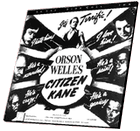

USA film school
1941
bw 119 min.
Director: Orson Welles
CAV: $124.95 - available
3 discs, catalog # CC1259L
CLV: $39.95 - available
1 disc, catalog # CC1285L
Since the dawn of the sound era, an estimated 25,000 feature-length
films have been produced -- and that's in the English language
alone. When, in the early 1960s, an international group of film
critics were polled as to their "number-one film of all time,"
Citizen Kane was in first position. The repetition of this poll
in the early 1970s and once again in 1982 produced the same result:
Citizen Kane was a solid first each time. Even more important
than the opinion of the critics is the opinion of the audiences. They
too, decade after decade, have ranked Citizen Kane as their
favorite film. For what truly sets Kane apart from every other film
commonly called a "masterpiece" is that it's also an enormous amount
of fun.
If one thinks about it, the very idea that there could be
unanimity of opinion on such a subject as "the best movie ever made"
is absurd. Not only have different generations viewed movies
differently, but groups within each film-going generation seek
different things. Some search for an aesthetic experience; others look
for social relevance; still others rank storytelling as the ultimate
purpose of a film; and yet another group believes insight into human
psychology is the special province of film. Citizen Kane's
accomplishment is, simply, that it achieves greatness whatever one's
perspective may be.
Despite the fact that Citizen Kane can't
truly be called "art" -- or perhaps because of it -- its greatness is
undeniable. While some critics have gone so far as to call Kane
kitsch, such people tend to regard estrangement from popular
entertainment as proof of worth. In stylistic terms, the film is an
amalgam of many forms of popular entertainment -- the historic radio
plays, the breakneck pace of vaudeville comedy, the cheap emotions of
pulp fiction, the phony drama of the newsreel, the cartoon-like,
larger-than-life quality of the characters. It is these "popular"
qualities which underlie the film's extraordinary claims on our
attention.
While numerous individual elements of the film are truly
artistic -- cinematographer Gregg Toland's deep-focus camera work
leaps to mind -- those elements are subservient to what was presumably
Welles' original purpose, and certainly his ultimate effect: to grab
the audience from the very first frame and take it on a breathless
roller-coaster ride through early 20th-Century America, leaving it at
the end of the trip exhilarated and spent, but begging for more.
As
for the social relevance of Citizen Kane, it -- like the film's
art -- is there when needed but always subjugated to the film as grand
entertainment. At the time of Kane's release, social
commentators (particularly on the Left) felt the film failed to
inveigh sufficiently against the abuse of wealth and power by such as
Kane/Hearst. Instead, it tells the audience what it already believes:
money doesn't buy happiness. While the absence of a desire to
transform human consciousness may bother some, for most of us
Kane-as-Daddy Warbucks, lonely despite vast riches, is a far more
engaging character than the malefactor of great wealth some would have
him be.
It is in the telling of the story of Charles Foster Kane
that the film transcends the limitations of popular entertainment and
achieves greatness. That it does it through the devices of popular
entertainment is irrelevant. From the first moment when the camera
conspiratorially draws the viewer behind the giant iron gate with its
"No Trespassing" sign, to the final moment when the sled is consumed
by flames, every aspect of cinematographic art -- photography, music,
set design, editing, costuming, special effects -- is assembled with a
unifying vision into an endlessly fascinating portrait of a
not-all-that-fascinating man.
The New York opening of Citizen
Kane was at Broadway's RKO Palace, newly converted from a
vaudeville house, on May 1, 1941. While from the beginning the film's
extraordinary quality was recognized, it was not what today would be
called a blockbuster. Its initial release earned RKO most, but not
all, of its total cost -- as Hearst-inspired fears of booking on the
part of many exhibitors probably contributed to its failure to earn a
profit. However, beginning in the 1950s, a series of releases brought
the picture to the attention of a new generation of filmgoers. Most of
them saw the film in grainy 16mm prints in "art" houses. Despite all
of the attention the film has subsequently received, few viewers have,
according to Welles himself, seen the film as he intended it to be
seen.
It is with a great sense of privilege that we present this
Criterion edition, which we believe is as exact as possible a
recreation of Welles' masterpiece. This videodisc was derived from a
fine grain master positive provided by the UCLA Film and Television
Archives. Every possible form of electronic enhancement techniques has
been used to make this videodisc the closest approximation of the
experience Welles intended to give the viewer. Citizen Kane
deserves nothing less.
-- ROGER P.
SMITH
Credits
Director/Producer: Orson
Welles
Original Screenplay: Herman K. Mankiewicz and Orson
Welles
Photographer: Gregg Toland
Music Composer/Conductor:
Bernard Herrmann
Transfer
This special anniversary
edition of Citizen Kane was transferred digitally from an
archival 35mm fine grain print made from the original
negative.
Go to Voyager's Orson Welles site






